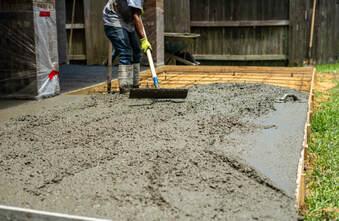Concrete is a durable and versatile building material, but it requires regular maintenance to ensure its longevity and performance. Proper maintenance can prevent minor issues from becoming major problems, saving you time and money in the long run. As a trusted concrete company in Aurora, CO, Aurora Concrete Services is dedicated to providing expert advice and services to help you maintain your concrete structures effectively. In this comprehensive guide, we will cover essential concrete maintenance tips, including preventive measures, routine care, and repair techniques, ensuring your concrete surfaces remain in excellent condition.
Understanding the Importance of Concrete Maintenance
Concrete is inherently strong and resilient, but it is not impervious to wear and tear. Environmental factors, usage patterns, and natural aging can all impact the condition of concrete surfaces. Regular maintenance helps to:
- Preserve Structural Integrity: Preventing cracks and other damage keeps concrete structures safe and functional.
- Enhance Appearance: Well-maintained concrete looks better and adds to the curb appeal of your property.
- Extend Lifespan: Proper care can significantly extend the life of concrete surfaces, reducing the need for costly replacements.
Routine Maintenance Tips
1. Regular Cleaning
Keeping your concrete surfaces clean is the first step in maintaining them. Dirt, debris, and stains can accumulate over time, leading to discoloration and surface damage.
How to Clean Concrete:
- Sweep Regularly: Use a broom to remove loose dirt and debris.
- Power Washing: For stubborn stains and grime, use a power washer with a mild detergent. Be cautious with the pressure setting to avoid damaging the surface.
- Stain Removal: Treat oil, grease, and other stains promptly with appropriate cleaning agents.
2. Sealing Concrete
Sealing concrete surfaces provides a protective barrier against moisture, chemicals, and wear. It helps prevent cracks, spalling, and other forms of damage.
When to Seal Concrete:
- New Concrete: Wait at least 28 days before applying the first sealant.
- Existing Concrete: Reapply sealant every 2-3 years, or as recommended by the manufacturer.
How to Apply Sealant:
- Clean the Surface: Ensure the concrete is clean and dry before applying the sealant.
- Choose the Right Sealant: Select a sealant appropriate for your specific type of concrete and environmental conditions.
- Apply Evenly: Use a roller or sprayer to apply the sealant evenly, following the manufacturer’s instructions.
3. Controlling Moisture
Moisture is one of the primary causes of concrete damage. Controlling moisture levels around your concrete surfaces can prevent issues like cracking and spalling.
How to Control Moisture:
- Proper Drainage: Ensure proper drainage around concrete structures to prevent water accumulation.
- Repair Leaks: Fix any plumbing leaks or water intrusion issues promptly.
- Use Moisture Barriers: For concrete slabs, use moisture barriers to prevent ground moisture from seeping up.
4. Managing Vegetation
Vegetation, such as trees and shrubs, can impact concrete surfaces through root growth and moisture retention.
How to Manage Vegetation:
- Trim Regularly: Keep vegetation trimmed and away from concrete surfaces.
- Root Barriers: Install root barriers to prevent roots from undermining concrete structures.
Preventive Measures
Preventive maintenance can significantly reduce the likelihood of concrete damage and prolong the life of your concrete surfaces.
1. Joint Maintenance
Expansion and control joints in concrete help manage the natural expansion and contraction of the material. Maintaining these joints is crucial for preventing cracks.
How to Maintain Joints:
- Clean Joints: Keep joints free of debris and vegetation.
- Inspect Regularly: Check for signs of wear or damage.
- Seal Joints: Apply a joint sealant to prevent water infiltration and protect the joint material.
2. Applying Protective Coatings
In high-traffic areas or environments exposed to harsh conditions, applying protective coatings can add an extra layer of defense against wear and damage.
Types of Protective Coatings:
- Epoxy Coatings: Ideal for garages and industrial floors, providing a durable and chemical-resistant surface.
- Polyurethane Coatings: Offer excellent abrasion resistance and are suitable for exterior surfaces.
3. Reinforcement and Repairs
Addressing minor issues promptly can prevent them from becoming major problems. Regular inspections and timely repairs are essential for maintaining concrete integrity.
Common Repairs:
- Crack Repair: Use epoxy or polyurethane injections to fill and seal cracks.
- Spalling Repair: Apply a patching compound to restore the surface.
- Surface Refinishing: Use resurfacing products to renew the appearance of worn or damaged concrete.
Concrete Repair Techniques
Despite regular maintenance, concrete surfaces may still require repairs over time. Here are some common repair techniques:
1. Crack Repair
Cracks can occur due to various factors, including settling, temperature changes, and heavy loads. Repairing cracks promptly is crucial to prevent further damage.
How to Repair Cracks:
- Clean the Crack: Remove any debris and loose material from the crack.
- Choose the Right Filler: Select an appropriate crack filler, such as epoxy or polyurethane.
- Apply the Filler: Inject or apply the filler into the crack, ensuring it is filled completely.
- Seal the Surface: Apply a sealant over the repaired crack to protect it from moisture and further damage.
2. Resurfacing
Resurfacing involves applying a new layer of concrete or a specialized resurfacing compound over the existing surface to restore its appearance and functionality.
How to Resurface Concrete:
- Prepare the Surface: Clean and repair any existing damage on the concrete surface.
- Mix the Resurfacing Compound: Follow the manufacturer’s instructions to mix the resurfacing material.
- Apply Evenly: Spread the resurfacing compound evenly over the concrete using a trowel or squeegee.
- Finish the Surface: Use a finishing tool to achieve the desired texture and appearance.
3. Patching
Patching is used to repair small areas of damage, such as holes, spalling, or surface imperfections.
How to Patch Concrete:
- Clean the Area: Remove any loose material and clean the damaged area.
- Apply a Bonding Agent: Use a bonding agent to ensure the patch adheres properly.
- Fill the Area: Apply a patching compound to the damaged area, smoothing it out with a trowel.
- Cure Properly: Allow the patch to cure according to the manufacturer’s instructions.
Conclusion
Regular maintenance and timely repairs are essential for preserving the integrity and appearance of your concrete surfaces. By following the tips and techniques outlined in this comprehensive guide, you can ensure that your concrete structures remain durable and functional for years to come. Whether you need routine maintenance or concrete repair in Aurora, CO, Aurora Concrete Services is here to help. As a leading concrete company in Aurora, CO, we offer a wide range of services to meet all your concrete needs. From installing a new concrete driveway in Aurora, CO, to repairing and maintaining existing structures, our experienced team is dedicated to providing high-quality solutions and exceptional customer service. Contact us today to learn more about our services and how we can assist you with your concrete maintenance needs.






